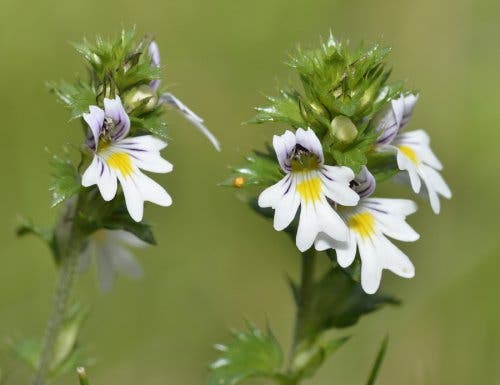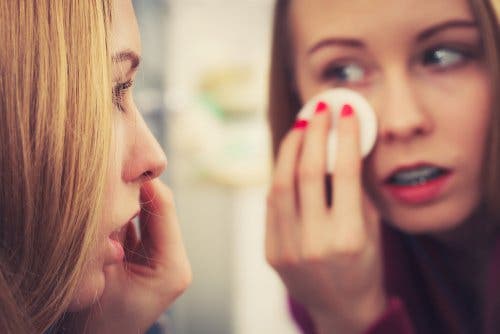4 Herbs to Speed Up the Healing of Styes

A stye is an acute inflammation caused by an infection that causes eyelid pain, tenderness, and swelling. Today, you’ll discover some herbal solutions to speed up the healing of styes so that you can get rid of them as soon as possible.
Although they’re generally mild and self-limiting, sometimes they can cause complications and serious discomfort. For this reason, you can use any of the herbal remedies we’ll propose in this article as a complement to the treatment indicated by your doctor.
Herbs to speed up the healing of styes
As stated in the article “Most frequent causes of ophthalmological visits”, styes are caused by bacteria of the genus Staphylococcus. If you have blepharitis, you don’t have good face hygiene (such as removing your makeup), or you don’t wash your hands enough, then you can easily catch them.
1. Eyebright

The article “Evidence of the use of medicinal plants in eye infections” presents this plant as an option to speed up the healing of styes. The reasons why it can be a great option are that it:
- Relieves eye irritations
- Acts directly on the mucosa
- Has an astringent activity
- Has antimicrobial and antiseptic properties
One way to use eyebright is to prepare an infusion with it. Then, dip a compress or a sterile gauze in it and apply it on your closed eyelids for five minutes. Also, you can use this preparation to wash your eye carefully.
You may like this article: 5 Natural Solutions for Curing Styes
2. Greater celandine
Greater celandine is another option to speed up the healing of styes. This plant has very beneficial properties that can help improve the appearance of styes and favor their disappearance in a few days. For example, this plant:
- Has antiviral properties
- Has antibacterial activity
- Helps deflate the eyelids
As in the previous case, the best way to use this herb for styes is to prepare an infusion with it. Next, take a gauze or a compress and moisten it well in the preparation.
You must be careful not to dip the gauze in overly hot water, as placing it on your eye can harm it. Thus, it’s important to make sure it’s warm so that you can keep it on for five minutes without suffering any kind of burn.
3. Common marigold

In addition, common marigold can also be of great help to speed up the healing of styes. Among its various characteristics and properties, we can highlight the following:
- Anti-inflammatory properties
- Great healing power
- Antibacterial properties
All this means that it’s a great remedy to help speed up the healing of styes. The best way to take advantage of all its properties is to make a poultice. For this, prepare a normal infusion with common marigold leaves.
When the water boils, put them in gauze or a compress and cover them. With your eyes closed, apply this poultice where you have the stye and wait for five to ten minutes.
This article may interest you: 8 Effective Remedies that Treat Styes
4. Green tea
The last option to speed up the healing of styes is green tea. An infusion that, surely, you have at home and whose properties are not only beneficial for your health but also for your skin.
The beneficial properties of green tea come, in part, from the polyphenols it contains. These are the ones that give it some of the following properties that will help speed up the healing of styes:
- Antiviral
- Anti-inflammatory
- Antiallergic
It’s important to apply this remedy as a compress or poultice, as we mentioned earlier. Also, you must be patient and do this once every day.
Additional tips to speed up the healing of styes

In addition to applying these remedies to speed up the healing of styes, it’s necessary to take some tips into account. These are important if you’ve been suffering from styes for a while.
Maybe you don’t properly remove your makeup before bedtime. This is very important, since you mustn’t forget that eyeshadow or mascara can cause the appearance of styes. In addition, it’s essential to use suitable products for the eyes.
Likewise, you have to pay attention if you touch or scratch your eyes a lot. Remember that your hands aren’t always clean, and this can favor the appearance of styes.
If you continue to suffer from styes quite frequently, despite the remedies we shared above, don’t hesitate to talk to a doctor you can trust. They’ll advise you on the best way to find the root cause of this problem.
Do you suffer from styes quite frequently? Are they minor or, on the contrary, do they cause serious eye swelling? We hope that these herbal remedies can help you and that you’re now much more aware that removing your makeup every night (or washing your hands) is necessary to prevent them.
All cited sources were thoroughly reviewed by our team to ensure their quality, reliability, currency, and validity. The bibliography of this article was considered reliable and of academic or scientific accuracy.
- García-Rodríguez, M. C., Vilches-Larrea, R. E., Nicolás-Mendez, T., & Altamirano-Lozano, M. A. (2012). El té verde en la quimioprevención in vivo del daño genotóxico inducido por metales cancerígenos (cromo [VI]). Nutrición Hospitalaria, 27(4), 1204-1212.
- Lastra Valdés, Humberto, & Piquet García, Rosario. (1999). Calendula officinalis. Revista Cubana de Farmacia, 33(3), 188-194. Recuperado en 22 de marzo de 2019, de http://scielo.sld.cu/scielo.php?script=sci_arttext&pid=S0034-75151999000300007&lng=es&tlng=es.
- López de Letona, C.. (2006). Remedios oftálmicos en la materia médica de Dioscórides (II). Archivos de la Sociedad Española de Oftalmología, 81(5), 301-302. Recuperado en 22 de marzo de 2019, de http://scielo.isciii.es/scielo.php?script=sci_arttext&pid=S0365-66912006000500011&lng=es&tlng=es.
- Mengual-Moreno, E., Lizarzábal-García, M., Hernández-Rincón, I., & De Freitas Barboza-Nobrega, M. (2015). Hepatotoxicidad asociada a hierbas y productos nutricionales de origen botánico. Investigación Clínica, 56(3), 320-335.
-
Novy P, Davidova H, Serrano-Rojero CS, Rondevaldova J, Pulkrabek J, Kokoska L. Composition and Antimicrobial Activity of Euphrasia rostkoviana Hayne Essential Oil. Evid Based Complement Alternat Med. 2015;2015:734101. doi:10.1155/2015/734101
- Parente, L. M., Lino Júnior, R., Tresvenzol, L. M., Vinaud, M. C., de Paula, J. R., & Paulo, N. M. (2012). Wound Healing and Anti-Inflammatory Effect in Animal Models of Calendula officinalis L. Growing in Brazil. Evidence-based complementary and alternative medicine : eCAM, 2012, 375671. https://doi.org/10.1155/2012/375671
- Miraj, S., & Alesaeidi, S. (2016). A systematic review study of therapeutic effects of Matricaria recuitta chamomile (chamomile). Electronic physician, 8(9), 3024–3031. https://doi.org/10.19082/3024
-
Novy P, Davidova H, Serrano-Rojero CS, Rondevaldova J, Pulkrabek J, Kokoska L. Composition and Antimicrobial Activity of Euphrasia rostkoviana Hayne Essential Oil. Evid Based Complement Alternat Med. 2015;2015:734101. doi:10.1155/2015/734101
This text is provided for informational purposes only and does not replace consultation with a professional. If in doubt, consult your specialist.








